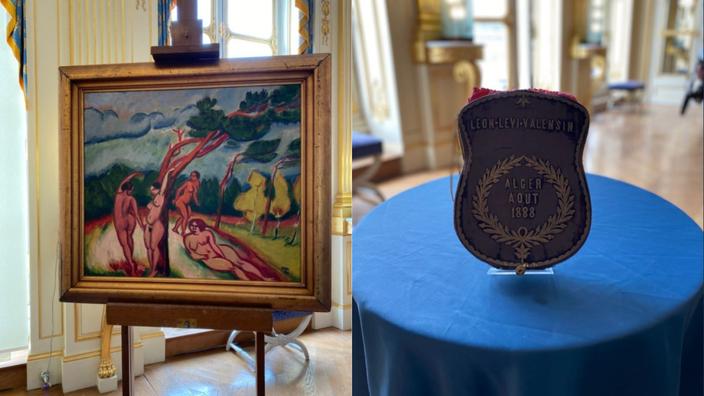Almost 90 years after their theft, the objects have finally returned to their rightful owners.
Thursday, during a ceremony at the Ministry of Culture, a painting by the German expressionist Max Pechstein and a modest bag of speech bubbles (prayer bag) were returned to the beneficiaries of two Jewish families.
Two very different objects in terms of their material value, illustrating the diversity of spoliations carried out by the Nazis under the Occupation.
The painting is the work of Max Pechstein, a painter and graphic designer from Zwickau, Germany, known for his mastery of German Expressionism. Entitled
Nudes in a Landscape
, this canvas painted in 1912 was stolen during the war from the Parisian apartment of German Jewish banker and collector Hugo Simon. The latter had settled in France as soon as Hitler came to power in 1933. Opposed to Nazism from the start, he helped Jewish refugees in France and was described by the Nazis as "
a typical Marxist Jew and capitalist
". He ended up taking refuge with his family in Brazil in 1941 under an assumed identity.
It was his great-grandson, Rafael Cardoso Denis, who learned as an adult that his ancestors had been despoiled and who fought for the restoration of the painting.
In 1966, the painting reappeared at the Palais de Tokyo, before being entrusted to the Georges Pompidou National Museum of Modern Art (MNAM).
After its return, the beneficiaries will lend it provisionally to this museum, which will reserve a special room for the renowned art lover that Hugo Simon was in Germany before 1933.
Read also: Pissarro looted by the Nazis: French justice outraged by the attitude of the American museum
As for the bag of phylacteries, it had been offered in Algiers in 1888 for his bar mitzvah to the young Elie Léon Lévi-Valensin, who was to become a famous lyric artist. It was stolen with other objects during the looting in 1942 of the apartment in Paris of his son Marcel Georges, a renowned doctor. The great-granddaughter of Elie Léon, Miléna Kartowski-Aïach, told how chance had made her find this object of no other value than religious during the exhibition
Jews of Algeria
at the Museum of Art and history of Judaism in 2013. At the end of her intervention, the young woman sang with gravity a long Jewish prayer, the Kedushat Keter, in front of a collected audience.
"
This little bag carries a great memory. Everyday objects were the target of the eradicators. To steal them, to destroy them, it was to attack what made the intimacy
of the families, underlined the Minister of Culture Roselyne Bachelot. These are two renditions "
in families who were not from the same social background
", she stressed, indicating the government's firm desire to speed up the renditions. Thus 24 works and objects were able to be returned last year, she said. On Twitter, Haïm Korsia, Chief Rabbi of France, thanked the minister
"for working so well to repair these terrible spoliations".
“Even long after, these historic moments are a source ofappeasement for families so hard hit ”,
he said. There are an estimated 100,000 objects of art and works seized in France by the Nazis during the Occupation.

